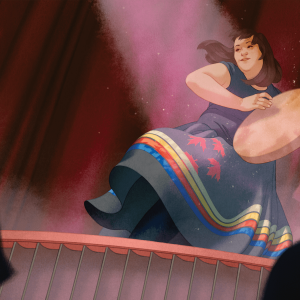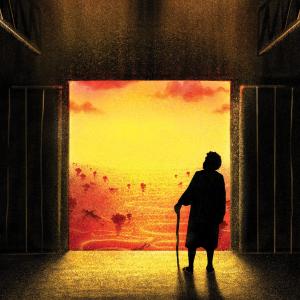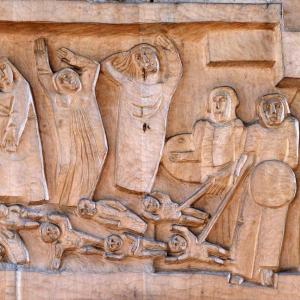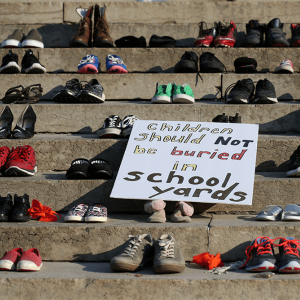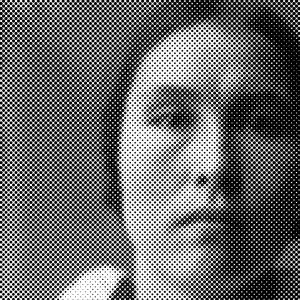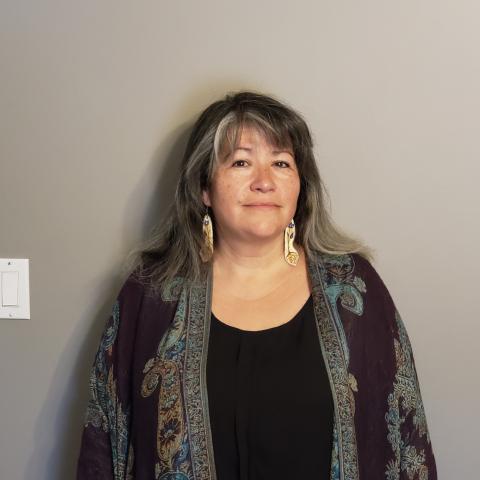
Patty Krawec (@gindaanis) is an Anishnaabe woman from Lac Seul First Nation, the co-host of the podcast Medicine for the Resistance, and a member of Chippawa Presbyterian Church. You can find more of her writing at Aambe on Substack. She lives in Niagara Falls, Ontario.
Posts By This Author
Can Christianity and Indigenous Worldviews Ever Be Reconciled?
The call and response of our songs is a kind of reciprocal relationship, one that I hope you have heard.
This article is adapted with permission from Becoming Kin: An Indigenous Call to Unforgetting the Past and Reimagining Our Future by Patty Krawec. © 2022 Broadleaf Books.
I WAIT AT the back of the stage, behind the curtains, holding my hand drum and listening to the low buzz of a theater filled with people. My friend Karl stands in the darkness at center stage, waiting for me to start singing and make my way to where he stands. We are providing an opening for the Niagara Performing Arts Center’s season preview. It is not a Native event. The center is a public arts venue that showcases a wide range of performers, and the artistic directors include Native artists throughout the regular season. They have asked Karl and me to open this particular night as an acknowledgment that this and future events take place on Haudenosaunee and Anishinaabe land.
It is fall 2017, 150 years since Canada’s confederation, and I’ve made a ribbon skirt to wear at this event. Ribbon skirts—long cotton skirts embellished with rows of ribbon and sometimes with appliqued designs—are a contemporary innovation of an older style of clothing that we wore before settler contact. The ribbon skirt I’ve made for this evening is black with wide ribbons in the colors associated with the medicine wheel: red, black, white, and yellow. I have appliqued red maple leaves falling down the front of the skirt until they are covered by ribbons. I like the imagery of Canada being absorbed by Indigenous ideas. Later, during the gathering after the event, a couple of women will come to speak with me. They will comment that the leaves are upside down. A nation in distress flies their flag upside down, I will tell them. And Canada, like the United States, is a nation in distress.
There is the beat of the drum in that darkened theater and then my voice coming from the back of the stage. I move toward the front, singing each verse louder as the lights come up. When I finish, Karl speaks the words of the Haudenosaunee Thanksgiving Address in Oneida. Then we simply leave the stage. Not explaining the song or our actions or our words is deliberate. We let the audience sit for moment and consider that what feels profoundly alien to them is not alien at all. For one brief moment, they are surrounded by the sounds of this place.
That evening before we go on stage, Karl and I talk about whether Christianity and Indigenous worldviews can ever be reconciled, if there is any common space. He doesn’t think so. Karl is Oneida and part of the Haudenosaunee Confederacy. Hundreds of years ago, when it became evident that the newcomers were going to stay, he says, the Confederacy made a treaty with the settlers called the Two Row. This is written in the form of a wampum belt made of oblong purple and white beads, with two white rows on a purple background. The agreement was that we would travel together, the Indigenous peoples and the settlers, each in our own boat but on parallel paths in a relationship guided by peace, honesty, and respect.
The principle of noninterference lives at the root of many Indigenous philosophies and is exemplified in treaties like the Two Row: We would live according to our ways, and the newcomers would live according to theirs. Although colonization is clearly a violation of this treaty, the Haudenosaunee people I know remain committed to it and continue to try to live within these principles.
Why Was Noah Silent at the End of the World?
NOAH'S ARK IS a strange children’s story. We decorate nurseries and bedrooms with animals marching two-by-two. The images festoon baby items and fill the pages of countless children’s books. I’ve sat on the floors of many church nurseries playing with babies and Noah’s ark toys and questioned its appropriateness. I’ve thought about Noah and his family closing the door and being sealed inside. I’ve thought about them hearing the sound of rain and the people banging desperately on those closed doors. I’ve thought about the cries and the banging becoming quieter and quieter, about the gut-wrenching silence as the voices were swallowed by the sound of rain.
In a recent essay on her blog, Life is a Sacred Text, Rabbi Danya Ruttenberg notes that while the Bible calls Noah a “righteous man, blameless in his generation” (Genesis 6:9), the Zohar, a Kabbalistic text that first appeared in 13th century Spain, doesn’t see him so favorably. The author ties him not to the survival of the animals but to the deaths of everyone else. “Noah did not plea for mercy on behalf of the world, and they all perished, because the Holy One ... had told him that he and his children would be saved by the ark” (Zohar 1:67b). Noah’s complicity in the people’s deaths is so bad that, in Isaiah, the floodwaters are named after him: “For this is as the waters of Noah to me; as I have sworn that the waters of Noah should no more go over the earth” (Isaiah 54:9, emphasis mine).
Refusing to Be Comforted
What Rachel's lament teaches us about the work of repairing relationships
In Matthew’s gospel, King Herod fears a threat to his authority after the birth of Jesus, who the Magi call “king of the Jews.” So he acted as Pharoah had done thousands of years earlier, and ordered the slaughter of male children. On the Feast of the Holy Innocents (Dec. 28), many churches read and reflect on the horror of slaughtered infants. I read it in September while preparing a church service acknowledging the legacy of Canadian residential schools.
Indigenous Boarding Schools and the Responsibility We Inherit
Indigenous people knew the graves were there. Canada’s investigation, the Truth and Reconciliation Commission, which ended in 2015, contained a large section on unmarked graves. Survivors in Canada and the United States talked about these mass graves, but people didn’t hear them, so when the graves were uncovered, people were shaken. But that level of emotional intensity is hard to maintain. The emotions the news elicits are painful — so after the speeches and the promises, equilibrium is restored and things go back to normal. To business as usual.
Christians Romanticize Wandering Yet Rendered My People Homeless
The church was an accomplice in stripping home and identity from me and my ancestors. But the church can also bring freedom.
HOME. PERPETUAL WANDERING is a crucial aspect of the Christian narrative. Cast from Eden, Christians are forever strangers in a strange land.
But for black and Indigenous people, that means something very different. If the original sin of the colonized West is genocide and slavery, that is not our sin. And yet it rendered us homeless as surely as the apple in the Hebrew narrative. Forcibly uprooted again and again, black and Indigenous people seek to create, and return, home.
Indigenous scholars such as Kim TallBear and Kim Anderson have described the power that the American idea of home has on the minds of people and politics, and the threat posed to that ideal by Indigenous families who did not live in nuclear relationships with women in a subordinate role. Historically, land allotments for settlers seeking to homestead or for Indigenous people were allotted to heads of households based on the size of households; having a wife and children ensured a larger allotment. Indigenous people who were determined to be more than “half-blood” were not given land outright but had their allotment held in reserve because they were not considered capable of managing the land themselves.
The founders of the United States and generations of subsequent legislators defined the home in narrow and specific terms, creating laws and policies that ensured that free blacks, Indigenous people, immigrants, and poor whites were unable to achieve this American Dream. Vagrancy laws separated families and jailed people under vague and arbitrarily written codes. The Homestead Act, while providing land for settler families, required clearing the West of the people living there. People were framed as “nomadic” in order to justify the theft. The practice of redlining, marking boundaries around primarily black neighborhoods, was used to deny mortgages and exclude black families from home ownership.
The homeless, whatever their stories, are still viewed as suspect by Western society. People whose sexuality does not conform to the American ideal have long been described as threats to marriage and family, and many landlords rely on their Christian beliefs to justify denying homes to LGBTQ people. Yet around the world, U.S. media promotes a glowing image of the American home and family—making promises the country refuses to keep.
The church’s role
SO IT'S A strange dissonance in church, singing songs about wandering and seeking a home when, as an Indigenous woman, my homelessness is because of the church’s role in empire and colonization. This was not just complicity, but active engagement, directing the process and benefiting from the displacement and forcible relocation of black and Indigenous people, as well as from foreign wars that destabilize other countries and generate refugees and asylum seekers.
It was a pope who wrote the so-called Doctrine of Discovery, giving colonizers rights over our land; Justice Ruth Bader Ginsberg cited it to deny an Oneida land claim in 2005. It was the churches who ran residential schools and whose missionaries paved, and continue to pave, the way for capitalism and colonial government by marketing the constructed idea of home as a Christian ideal and model.
